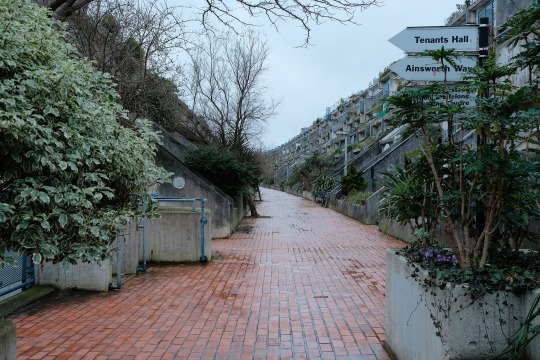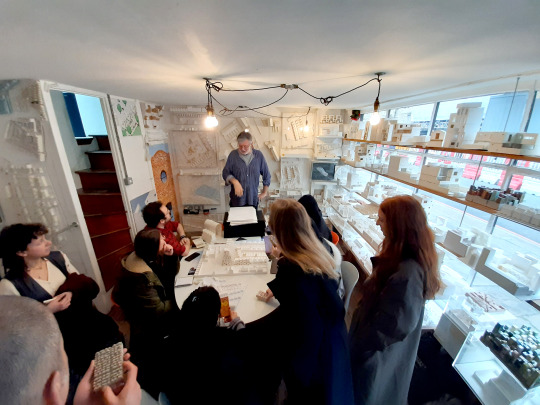#neave brown
Explore tagged Tumblr posts
Text

A run through the Alexandra and Ainsworth Estate, Camden, London
#London#Alexandra and Ainsworth Estate#architecture#brutalist#brutalism#urban#urban photography#social#housing#Neave Brown#England#UK
304 notes
·
View notes
Text






Alexandra Road Estate, London, designed by Neave Brown. Photos by Scott Wylie, 2022. (Wikimedia Commons)
220 notes
·
View notes
Text

Alexandra & Ainsworth Estate
London
Architect: Neave Brown
3 notes
·
View notes
Text
What did Jesus Look Like?
This has been a question hotly debated among Christian scholars and theologians for decades. I'm not going to pretend that I'll be the one to figure this out, but simply compile the evidence and let you come to your own conclusions.
Before we attempt to create an image of Jesus, there are some cultural considerations to be made.
First off, we know that the modern image of Jesus with long brown hair, white skin, and blue eyes is entirely facetious. This version of Jesus is speculated to be based on Cesare Borgia, a 15th century politician rumored for years to have been romantically involved with Leonardo da Vinci. Scholars often decry this claim, since there is no concrete evidence that da Vinci and Borgia were romantically involved, but it doesn't take much to see that da Vinci probably at least took inspiration from Borgia to create his image of Jesus.


A portrait of Borgia, left, contrasted with the restored Salvator Mundi by Da Vinci (right). [1][2]
It's important to note a margin of error in both of these images. We have no way of knowing how accurate the portrait of Borgia is, nor do we know if the restoration is 100% accurate. But if you look closely, Borgia's hair clearly indicates that it normally curls into ringlets, reflecting the image of Jesus, and on the Salvator Mundi, there is a shadow indicating what may have reflected Borgia's beard.
Da Vinci and Borgia did have, at the very least, a diplomatic partnership [2] and it is widely accepted among scholars that Da Vinci was attracted to men, citing a 1467 sodomy accusation where he, at 24, was said to have consorted with a 17-year-old sex worker.
As for the actual image of Jesus, we do know some things for certain. Jesus was described as a Jewish Galilean in Rome-occupied Israel/Palestine*. He held no Roman citizenship and was a second-class citizen due to his heritage. Many theologians draw connection between this position in society under occupied rule and the current conflicts in occupied Palestine; to say that Jesus was Palestinian is, therefore, both honors his Jewish heritage while placing him as a symbol of resilience against an oppressive system [see 3 for a great article by a Palestinian Christian about this!].
We know for certain where Jesus resided and his heritage; it's a major point in many stories of the Bible. Our question becomes-- what did Jewish Galileans look like 2000+ years ago?
Richard Neave, a forensic anthropologist, paints a very different picture of Jesus than that painted by da Vinci or Michaelangelo. Using an Israeli/Palestinian skull dated back to the 1st century, he created a digital reconstruction of a man that may have, hypothetically, been one of Jesus' neighbors.

A 2001 digital reconstruction of a first-century Israeli/Palestinian skull.
This is likely the closest we'll ever get to the image of Jesus, and it corresponds pretty closely to the only description of Jesus, which is present in Revelations 1 14:15.
" His head and his hairs were white like wool, as white as snow; and his eyes were as a flame of fire;
And his feet like unto fine brass, as if they burned in a furnace; and his voice as the sound of many waters. "
This description is of Jesus after he had risen, but some scholars take it to mean that his hair was wooly in texture.
So what did Jesus actually look like?
Well, we may never know his exact appearance until we meet him ourselves. According to the Bible, he was just a normal, poor-looking dude from 1st century Galilee, born in Bethlehem and raised in Nazareth. The question becomes what people looked like back then, 2000 years ago?
[buy me a coffee]
[1] [2] [3] [4]
* I am not fully educated on the Israel/Palestine conflict; the Bible describes Jesus' homeland as being Israel, but the word Palestine is just as old historically, and the Bible is not a historical text.
8 notes
·
View notes
Text
friendly reminder before christmas ends that is what jesus would have ACTUALLY looked like based upon forensic science and anthropology founded by a team of experts led by Dr Richard Neave, formerly of the University of Manchester. jesus christ, the christian lord and saviour, was a brown man from bethlehem who would have spent his first days in rubble in he were born today under israeli apartheid occupation.
#zo’s info#🇵🇸🍉#boost this post!!#palestine#palestine resources#education on gaza#palestine education#never stop speaking about palestine#jesus was a palestinian man#jesus would be born under rubble#jesus would stand with palestine#free palestine#this isn’t a war it’s a genocide#israel is a terrorist state#no one is free until we are all free#zo ✬#zoramones
6 notes
·
View notes
Text

Dunboyne Road Estate, Gospel Oak, Camden
1971-77
Neave Brown for Camden Borough Architects' Department
Image from RIBApix
Camden Architects' Department
40 notes
·
View notes
Text
REVIEWING THE CHARTS: 23/03/2024 (V of BTS and... Mark Knopfler?)
It’s a short week, largely to prepare for what chaos should be coming the next, but right at the top, Benson Boone clenches his first ever #1 with “Beautiful Things”. I know pretty much no-one who cares about pop music on a deeper level likes this song, but hey, if I’m the only person happy about this other than Booner Boy himself, I’ll take it. Welcome back to REVIEWING THE CHARTS!

Rundown
Given our few new songs, we also only have a handful of notable dropouts to start with, so we’ll bid adieu to the small but decent selection of “Could You be Loved” by Bob Marley & The Wailers, “Angel Numbers / Ten Toes” by Chris Brown, “My Love Mine All Mine” by Mitski and finally, “Disconnect” by Becky Hill and Chase & Status.
As for what’s back, we see returns for “Asking” by Sonny Fodera and MK featuring Clementine Douglas at #73 and, sigh, “Someone You Loved” by Lewis Capaldi at #68, and then a spattering of gains. Our most notable boosts are for “if u think i’m pretty” by Artemas at #59, “Wasted Youth” by goddard. and Cat Burns at #58, “We Ain’t Here for Long” by Nathan Dawe at #55, “Happier” by The Blessed Madonna featuring Clementine Douglas at #54, “Thank You (Not So Bad)” by a bestiary of enemies to good taste at #50, “Green & Gold” by Rudimental and Skepsis featuring Charlotte Plank and Riko Dan at #43, “Birds in the Sky” by NewEra at #34, “Never Lose Me” by Flo Milli surging high and fast up to #23 thanks to her releasing an album that includes a pretty great remix of the song featuring Cardi B and SZA, and then “Austin” by Dasha at #15, “Lovers in a Past Life” by Calvin Harris and Rag’n’Bone Man at #14 and finally, making his way into the top 10 for the first time, “Scared to Start” by Michael Marcagi at #10.
Our top five this week consists of “End of Beginning” by Djo at #5, “Lose Control” by Teddy Swims at #4, “TEXAS HOLD ‘EM” by Beyoncé at #3, “we can’t be friends (wait for your love)” by Ariana Grande at a new peak of #2 off of the debut, that could grab a week at the top soon, and of course, Benny Boone at #1. Now for our four new songs, which feel like names picked out of a hat and placed onto the chart.
New Entries
#60 - “Been Like This” - Meghan Trainor and T-Pain
Produced by Gian Stone and Grant Boutin
This is a joke, right? Or a soundtrack to a reality television competition, or daytime talk show? T-Pain has grown into his role as wholesome cuddly media figure surprisingly well and a collaboration with Meghan Trainor, whilst demonic, seems to be the best way to seal that position, with this being the lead single for her next album… Timeless. Well, that’s one thing to call your music. Mean jokes aside, hey, T-Pain is here so at least there’ll be some genuine, not as obnoxious charisma? Well, first of all, it’s electro swing, so my first instinct is to step away from my laptop, keel over and die, especially when Meghan starts to singing about how she keeps it juicy and then eventually that she’s “still that bitch”, as if she was ever that bitch to begin with. There’s something so cynical about Trainor’s vocals that I didn’t notice just the true extent of until T-Pain came in with an infectious call-and-response and weirdly-mixed but fun-extruding harmonies that almost would convince me on the entire song if he didn’t have to play to Meghan’s lack of personality, especially when placed against each other in the bridge. T-Pain can sell this as some goofy cartoon clown, but it probably wouldn’t charted without Ms. Trainor, who brings pretty much nothing to the song other than taking it a tad too seriously, despite the fact that there’s no reason, lyrically, for this to even be a duet. Also, Meghan, I’m not sure you can even sing the line about GRAMMYs in T-Pain’s verse on the account of you only have one.
#52 - “Never be Lonely” - Jax Jones and Zoe Wees
Produced by Jax Jones, Mark Ralph, Neave Applebaum and Tom Demac
I actually really like Jax Jones’ producer tag, it’s cute and rhythmic, has a little stutter to it. It’s nice. I have to say more than that, don’t I? I have to acknowledge Zoe Wees’ voice being misued and manipulated to just sounding characterless, I have to acknowledge how this heavily interpolates the drop from “Rhythm is a Dancer” by Snap!, one of the best Eurodance songs ever despite some… regrettable lines. It spent six weeks at #1 in 1992, blocking off Jimmy Nails, Freddie Mercury, Luther Vandross, Janet Jackson and of course, “Ebenezer Goode” by the Shamen from the top spot, before reappearing in remixed form in 2003 and 2008, reaching the top 40 again both times. “Never be Lonely” doesn’t work as an update of the song because of completely different lyrical content that I actually hate, asking someone to tell her how it feels that she’ll always be there for them, it’s really patronising and weird. It doesn’t work as a reimagining or reinterpretation because it goes for the same tone, and doesn’t adopt or adapt any of the original lyrical conceits. The one thing it does have is a Cascada remix. Yes, that Cascada. I have no idea why, but it exists.
#18 - “Going Home” (Theme from Local Hero) - Mark Knopfler’s Guitar Heroes
Produced by Guy Fletcher
Oh, so I guess this episode really will get as serious as cancer. This one might take a while to explain. So in 1983, Bill Forsyth wrote and directed Local Hero, a highly-acclaimed comedy drama that is actually former US Vice President Al Gore’s favourite film. Its soundtrack features a five-minute instrumental piece known as the “Theme of the Local Hero”. I’ve never seen the film so I don’t know how exactly it appears or makes sense within its narrative but I do know it has far transcended its origin. “Going Home” was the first single in Mark Knopfler’s solo career and has become a staple in both his and his band’s live performances, as well as becoming another theme, now for Knopfler’s home football team, Newcastle United. It’s probably the most lukewarm take of all time to say that “Going Home” is a beautiful piece, it honestly gives me goosebumps from its transcendent new-age introduction and excellently distant sax from Michael Brecker, that eventually transform into a very 80s-sounding but still profoundly triumphant jam that emulates the feeling of a journey in the UK pretty well. Maybe that’s what the film’s about, I don’t know. It peaked at #56 in 1983, whilst Bonnie Tyler’s “Total Eclipse of the Heart” was #1 - good week for rock epics, I guess.
If you know Knopfler from anything, it’s likely his band Dire Straits, one of the few important British rock bands that hit #1 in the States and never back over here on the islands - their #1 is of course “Money for Nothing”. The legacy of Dire Straits is not something tangible for me or that I’ve ever really understood, their sound was varied and evolved through what was ultimately a very short career. They’re not a legendary act but are still big names and incredibly well-connected, especially Knopfler, who has played and produced extensively for many artists and soundtracks. In January, Knopfler sold over 100 of his guitar and amp equipment at auction and in March, he’s compiled a charity ensemble to cover “Going Home” in support of cancer awareness.
Its status as a charity single is the only possible explanation for why this nearly 10 minute instrumental piece even touched the charts let alone the top 20, but it is stuffed with big names, from rock icons like Brian May, RIngo Starr and Joan Jett and newer cats like Sam Fender and Orianthi to genuine oddballs like Keiji Haino and head-scratching inclusions like, uh, Brad Paisley, who I will only ever remember for “Accidental Racist”. There are over 60 musicians on this record and damn near all of them contributed through their guitar playing, other than Ringo on drums, The Who’s Roger Daltrey on my favourite, the harmonica (that you can barely hear at times - Daltrey’s harmonica should be put to better use), and a few others. You can tell that Fletcher and Knopfler did their best job to try and collate recordings that were clearly from different times, places, equipment set-ups and audio qualities, but this is still basically a meandering pile of guitar overdubs that lasts longer than some full EPs and doesn’t really let you register any single guitarist as them playing. The collectiveness of it may just be the point, to show a united front against cancer or what have you, and there’s definitely a lot to appreciate if you’re an in-depth fan of guitar playing or a guitarist yourself, of which I’m not. I will admit, this is genuinely impressively easy to sit through for how lengthy it is, largely because of the dexterity on display, the fact that the melody of the original “Going Home”, even when developed on in the many ways it is within this piece, is still so infectious, and also because it comes out of not just cynical philanthropy but a genuine passion for the guitar as an instrument. The cover art is a Sgt. Peppers parody of the musicians standing in front of a famous guitar shop in London, and the wide array of musicians from a lot of different genres, eras and even techniques shows how wide and universal this feels an appreciation of the guitar… but I’ll say what my dad always said about Dire Straits (because, really, dads are the only people with viable Dire Straits opinions): “it all becomes much of a muchness.” My favourite of theirs is “Walk of Life” by the way, it’s so goofy. Love it.
#14 - “FRI(END)S” - V
Produced by Connor McDonough and Riley McDonough
V is the latest of the BTS boys to release a solo English single, seemingly leading towards a solo career like Jung Kook, with credits stacked full of Anglophone pop songwriters and production from the McDonough brothers that results in a very serviceable pop song that I’m not sure would get much attention outside of the fact that it’s a BTS member, hence why sales jacked this one’s chart position up so high. It’s not a bad little song at all, in fact I like the distorted guitar lick and the amount of emotion V shows in his vocals despite all the effects, he has a real unique texture against the slodgier indie drums and the infectious bed of harmonies in the pre-chorus. The one way I could see this getting big organically would be that fun albeit gimmicky chorus that makes this an anti-climactic friend zone anthem, though the gimmick wears off after the second time and doesn’t really develop into anything new in the second chorus other than some pretty gross, reverb-drenched spectacle. I usually wouldn’t give this manufactured bedroom pop much more of the time of day but there’s not much in the way of obnoxious performance or toxic lyrics here, it’s just that it really could be any other vaguely bitter male singer’s song. The first most obvious comparison is Joji due to their vocal textures, but Charlie Puth or Lauv could have easily made this work too, though probably not as well as V does here, especially not Puth. God, that would be horrible. Thank God for BTS that this song was never offered to Puth (not that he’d accept a song he didn’t spend 20 hours writing and producing himself, of course). Ugh, enough Puth talk, let’s end the episode.
Conclusion
God, this was not a great week, huh? Even if I’m not fussed about the new version, the composition of “Going Home” makes Mark Knopfler and friends get a lock for Honourable Mention, and it really does end up as the song with the most - if not the only - human passion in this selection. Worst of the Week goes to Meghan Trainor, surprise, surprise, for “Been Like This” with T-Pain, and that’s all. Future, Shakira, O-Rod, Tyla, Hozier, Headie One, Artemas, Cardi B, Lil Nas X, Bryson Tiller, they could all hypothetically show up next week and it would be a big one, so prepare for that and who knows what else? It’s 2024, anything can chart. As for now, thank you for reading, rest in peace to Cola Boyy but we go on and I’ll see you next week!
#uk singles chart#pop music#song reviews#mark knopfler#guitar heroes#dire straits#v#jax jones#zoe wees#cascada#meghan trainor#t-pain
3 notes
·
View notes
Text

The Romance Reader's Guide to Life (2017) by Sharon Pywell
Summary:
As a young girl, Neave was often stuck in a world that didn't know what to do with her. As her mother not unkindly told her, she was never going to grow up to be a great beauty. Her glamorous sister, Lilly, moved easily through the world, a parade of handsome men in pursuit. Her brother didn't want a girl joining his group of friends. And their small town of Lynn, Massachusetts, didn't have a place for a girl whose feelings often put her at war with the world -- often this meant her mother, her brother, and the town librarian who wanted to keep her away from the Dangerous Books she really wanted to read. But through an unexpected friendship, Neave finds herself with a forbidden copy of The Pirate Lover, a steamy romance, and Neave discovers a world of passion, love, and betrayal. And it is to this world that as a grown up she retreats to again and again when real life becomes too much. Neave finds herself rereading The Pirate Lover more than she ever would have expected because as she gets older, life does not follow the romances she gobbled up as a child. When Neave and Lilly are about to realize their professional dream, Lilly suddenly disappears. Neave must put her beloved books down and take center stage, something she has been running from her entire life. And she must figure out what happened to Lilly -- and if she's next. Who Neave turns to help her makes Sharon Pywell's the Romance Reader's Guide to Life one of the most original, entertaining, exciting, and chilling novels you will read this year.
The Browne Popular Culture Library (BPCL), founded in 1969, is the most comprehensive archive of its kind in the United States. Our focus and mission is to acquire and preserve research materials on American Popular Culture (post 1876) for curricular and research use. Visit our website at https://www.bgsu.edu/library/pcl.html.
2 notes
·
View notes
Text

NEW TAPES FOR SEPTEMBER!
Hello
Our September tapes are out now!
Check out at https://cruelnaturerecordings.bandcamp.com/
1) POUND LAND "Violence"
8 filthy tracks of vitriolic desperation set against a backdrop of nineties alt-metal industrial abstracted by psych doom and post-punk.
'Violence is an album that captures that sense of perpetual anger, frustration & ever-creeping hopelessness. Of course, it does all that while making a gloriously malevolent racket.' (4/5) - Andy Brown, Louder Than War
"Pound Land do not release music to drink beer to on a sunny Sunday. They are the real rage against the machine – an uncompromising, uncomfortably harsh grind that speaks hidden and unfortunate truths" (10/10) - Dark Juan, Ever Metal
2) DRAGGED UP "Hex Domestic EP"
New EP from the off-kilter psych-garage Glasgow proto-punk band, featuring members from Trembling Bells, Vom, The Owsley Sunshine & Las Mitras. Mentioned in the same breath as Scottish indie-rockers Teenage Fanclub and garage-punks The Primevals, 'Hex Domestic' presents four new tracks showcasing their seamless off-kilter cross-pollination of doom, psych, proto-punk, garage rock, and spoken word.
"like classic CBGBs proto-punk transplanted to rain-drenched Scottish streets"
- Nathan Whittle, Louder Than War
3) MIKE NEAVES "You're Welcome"
A masterpiece of 160bpm spidery fractured techno. The sound of the jittery Monday AM interior of your skull, & the mutant sounds of the weekender you wish you were at instead.
"With Aphex Twin having released his latest EP, Blackbox Life Recorder 21f, last month, fellow UK gadget wrangler Mike Neaves drops something that hits just as hard"
- Simon Kirk, Sun 13
4) SALISMAN & HIS UNWAVERING CIRCLE "Parched"
Fourth album from the Anglo-American group (Chicagoans Paul Foreman, Travis Salisbury & Jon Raedeke with Tyneside’s Chris Tate - Score; One Key Magic; d_rradio) continuing their expert fusion of psych Americana and shoegaze, through exceptional songwriting and production.
The soundtrack for troubled times: Rivers of synthesizers. Pedal steel drenched in warbling tape echo. Tense electronic rhythms and rustic percussion.
Enjoy!
Steve x
5 notes
·
View notes
Photo

Not all social housing in the 1960s was about tower blocks. High-rise buildings were unpopular with tenants, lifts were costly and broke down, and the surrounding lawns were hard to maintain. Moreover, on the slopes around Hampstead Heath in London, towers would have blocked views towards St Paul’s Cathedral. This area became part of the newly created borough of Camden in 1965 and a visionary new chief architect, Sydney Cook, assembled a bright team of assistants to find an alternative form of housing. One of these young architects was Peter Tábori, who has died aged 83. The Whittington estate which he designed, originally known as Highgate New Town, exemplified a solution that was both innovative and successful.
Camden had identified an area of semi-derelict Victorian housing for redevelopment next to Highgate’s east cemetery, where Karl Marx is buried. Tábori realised that, on such a steep hillside, lines of flats and maisonettes could be stacked one above the other and entered from a common entrance at mid-level on the uphill side. Car parking could be set into the hill between these terraces and decked over with pedestrian walkways and children’s playgrounds.
He was inspired by medieval Italian hill towns and an internationally regarded scheme near Berne by the Swiss architects Atelier 5, but the greatest impression is of generous, humane spaces. The scheme was designed in 1968-70 but not completed until 1979 after the original contractors went bust.
The concept fitted perfectly with Cook’s own ideas and Tábori was a natural addition to the team. Other assistants working on similar solutions went on to greater recognition: Neave Brown’s complex terraces at Fleet Road (now Dunboyne Road) and Alexandra Road are listed, as are Gordon Benson and Alan Forsyth’s mainly two-storey houses on a steep slope at Branch Hill, Hampstead.
Together the group established a distinctive style for Camden’s best social housing using crisp white concrete, densely packed but relatively low-rise. Tábori’s Highgate New Town had the benefit of simplicity, in the design of the terraces and in his determination that public and private spaces should be clearly separated. This last avoided the problems faced by estates where indeterminate space led to vandalism. Mark Swenarton’s book Cook’s Camden (2017), to which Tábori generously contributed, records the inspiring story.
Highgate New Town was finely finished, the external concrete contrasting with handsome internal joinery. Cook claimed that “the quality of [Tábori’s] work isn’t just double site capacity at low rise, or all the higher standards, but that he did it all below yardstick”, the restrictive budget code imposed by governments at the time. In fact, Camden’s fine housing was made possible by its high domestic rates income and other London boroughs could not match its quality. Many of Tábori’s maisonettes remain tenanted, but those sold under “right-to-buy” legislation now fetch eye-watering prices.
Tábori went on to design a second scheme in 1971, Oakshott Court, Polygon Road, with three L-shaped terraces, but he was disappointed by a decision made in 1974 to use brick, apparently in deference to its location near St Pancras Station. A smaller scheme of 15 flats on the corner of Mill Lane and Solent Road followed in 1973 after Cook’s retirement, including four wheelchair-accessible units and five for elderly people. He also worked on a visionary programme with the architects/engineers Arup Associates for building over the main railway tracks that run through Camden, an attempt to gain space in the overcrowded borough.
He was born Peter Stroh in Budapest, the son of Istvan Stroh, a professor of mathematics, and his wife Erzsebét (nee Szanto), a former opera singer. She subsequently married Michael Tábori, an economist whose father had died at Auschwitz. Both men had been imprisoned by the communist government and following the 1956 uprising in Budapest, Peter too was arrested. On his release in December 1956 he, Erzsebét and Michael emigrated to London via Vienna, along with other members of Michael’s family. Thenceforth Tábori used his stepfather’s surname and adopted it formally on becoming a British citizen in 1966.
Tábori learned English and technical drawing with an architect, Cecil Epril, and in 1958 entered Regent Street Polytechnic (now the University of Westminster). His tutors included Richard Rogers, who inspired his interest in mass housing, and who himself designed an (unbuilt) hillside scheme in Croydon inspired by Atelier 5. Tábori assisted on Rogers’s first built house, Creekvean, with Su Rogers and Norman Foster.
Tábori also spent two years working for Ernö Goldfinger, the Hungarian-born architect immortalised by Ian Fleming, before completing his qualifications. The final external examiner was Denys Lasdun, who gave him a job assisting on the University of East Anglia, another hillside building with a stepped section where he learned about concrete techniques. However, when in 1967 the chance came to work for Cook and develop his own housing interests, Tábori seized the opportunity.
He left the borough in 1984 and formed a private practice with John Green and Bob Winning, working mainly in Hamburg, Toulouse and Soweto.
Tábori married Angelika Schiel, a model, in 1962. They had three sons, Kris, Michael and Gabor, but divorced in about 1980, and Angelika, who became an upholsterer, died in 2016. Peter had a fourth son, Tom, in 1984, with Anne Saville, a welfare adviser at the charity Gingerbread, but the couple later separated. He is survived by his sons.
🔔 Peter Tábori (Peter Stroh), architect, born 15 January 1940; died 23 February 2023
Daily inspiration. Discover more photos at http://justforbooks.tumblr.com
16 notes
·
View notes
Photo










“Soane Medal Satellite Programme: A Tour of Peter Barber Architects” _ Peter Barber Architects, 173 King's Cross Road, London, WC1X 9BZ, UK _ Wednesday 29 March 2023 _ Photos by: Spyros Kaprinis [29.03.2023].
“As one of Britain’s most acclaimed architects and founder of Peter Barber Architects, 2022 Soane Medallist Peter Barber’s practice focuses on social housing and urban planning.
He has been widely celebrated for his inventive approach to design, delivering innovative housing which is both high-quality and affordable. Barber has also developed a number of speculative projects which respond to issues including the housing crisis and the revitalisation of de-industrialised areas.
In recent years Peter and his firm have received several awards, including a lifetime achievement award from the Architects’ Journal and IBA Neave Brown Award for Housing 2021. He was awarded an OBE for services to architecture last year and elected as a Royal Academician in January. Alongside his practice, Peter lectures on architecture at the University of Westminster and was recently invited by the government to lead a discussion on ‘Designing for Better Public Spaces’ with a team of top built environment professionals.”
https://shop.soane.org/products/soane-medal-satellite-programme-a-tour-of-peter-barber-architects-wednesday-15-march-12pm-1pm?variant=44251054145768
#A Tour of Peter Barber Architects#Peter Barber Architects#173 King's Cross Road#London#UK#Peter Barber#Spyros Kaprinis#LSBU#The Soane Museum#2023#2022 Soane Medallist
12 notes
·
View notes
Photo

The Abbey Road (yes as in the Beatles!) end of the Alexandra and Ainsworth Estate
The back of the estate is directly adjacent to the West Coast Mainline railway on its approach to Euston Station. The view from the train is very different as it just looks like the back of a football stadium towering above the track! Because of its proximity to the busy railway, architect Neave Brown designed the estate in such a way as to create a noise barrier. Further the foundations rest on rubber pads so as to eliminate vibration from the trains. I can genuinely say that during my visit I never consciously heard a single train.
#estate#housing#social#urban#brutalist#brutalism#architecture#Neave Brown#urban photography#documentary photography#concrete#alexandra and ainsworth estate#abbey road#beatles#camden#london#england#UK
161 notes
·
View notes
Video
Ashnikko - Worms from Raman Djafari on Vimeo.
Ashnikko in a monstertruck and a squad of develish beasts ride towards the sunset to battle the angelic overlord robots.
Credits: director - raman djafari // @ramandjafari executive producer - josef byrne head of production- Alex halley production company: blinkink @blink_ink
producer - jake river parker // @jakeriverparkerfilms animation producer - molly turner // @molly___turner production manager - rowan mackintosh king // @rowanmackintosh production assistant - maddy williams // @melodramaddy
commissioner- sam seager // @seagez
creative director - vasso vu @vassovu manager - george shepherd // @shepherdgeorge day to day manager - hannah browne // @hannahbr0wne
storyboards - raman djafari storyboards - mysie pereira // @mysiepereira animatic editor - Isabel gomez concept artist - Camille perrin
cg character design - raman djafari cg background design - raman djafari cg lighting, camera & layout - raman djafari cg character animation & rigging - dominic lutz // @domolutz cg character animation & rigging - harry bhalerao // @harrybhal cg character animation & rigging - barney abrahams // @_yenrab cg character animation & rigging - nate die // @spish.tv cg artist - sandrine gimenez // @sandrine_gimenez cg artist - klaas harm deboer cg artist - michael marczewski additional lighting - balasz simon // @notbalasz
vfx lead - john malcolm moore // @johnmalcolmmoore compositor - andrew khosravani // @andrew_khosravani compositor - vladislav enshin compositor - caroline terrago
1st ad - julia pavliuk // @ula__la dop - hunter daly // @hunterdalydp 1st ac - rupert hornstein // @ruperthornstein1966 2nd ac - nicola braid ac (prep day) - Joe mcdonald cam operator - tanmoye khan // @tanmoyekhan_dop dit - rosie taylor // @rosie_taylor_
gaffer - laurent arnaud // @sparkswars spark - johnjoe besagni // @jayjaybuzz spark - kieran brown // @k_brown_gaffer desk op - hudson daly // @hudson_daly led tech - pavel stici
vfx supervisor - john malcolm moore // @johnmalcolmmoore
production runner - leda contopanagos // @leda.echo production runner - krishita desai // @krishitadesai production runner - tom gonzalez // @mr_tamborine_man_ production runner - tom willows // @tomwillows_mash
art director - laura little // @laulit art assistant - jaclyn pappalardo // @jaclynpappalardo art assistant - chris dent art assistant (prep day) - jack boston oswald // @jackbostonoswald art assistant (prep day) - joshua douglas-warne art assistant (prep day) - Alexander king art assistant (prep day) - thabet kimili
stylist - holly wood // @hollyblowslightly stylist assistant - izzy frost // @iz_designz_
hair designer claire moore @clmorhair hair stylist mee kyung kim porter // @mee.hair.makeup mua - georgia olive // @georgiaolive mua assistant - carly roberts // @carlyroberts_ nails - imarni // @imarninails
bts content - eve mahoney // @evebelieve
edit - rich woolway edit assist - chris hutchings edit producer - Maggie mcdermott grade - coffee & tvt colourist - George neave colour producer - Kathryn tallis sound design - absolute post sound designer - rich Martin additional sound design - Daniel panayi additional sound design - paminos kyriazis sound design producer - Peter winslett
a special thanks to will hooper
13 notes
·
View notes
Text

Alexandra and Ainsworth Estate, Camden, London, Neave Brown, 1968.
Considered so dangerous and experimental that Neave Brown quit his job because he couldn't get any more work after, the estate today is highly awarded, applauded and lauded as some of the best modernist housing of the time Lesson: don't let the b*strds get you down
1 note
·
View note
Text

The Alexandra Road estate in Camden, North London, which is now Grade II*-listed. It was designed in 1968 by architect Neave Brown and built in 1978 #brutgroup photo by Ann Cator
0 notes
Text
Ebony Neave
General
Name: Blaine “Ebony” Neave
Nickname: Ebony
Age: 17 (v1-2)
Gender: cis male
Race: human
Symbol:

Affiliation(s): Team NCRM. ruby’s group, formerly Beacon Academy
The Character’s Appearance
Height: 6’3”
Eye Colour: blue-gray
Hair: black, cut short in the back but some bangs hang in his face. Usually parted in the middle. Very straight hair
Complexion: medium-light tan
Picrew 1 2


About The Character
Status: active huntsman, alive
Occupation: huntsman, former student
Handedness: ambidextrous. Will use this to drive people nuts when taking notes
Clothing: white shirt, black bomber jacket, dark blue/black jeans
Outfit Colors: whites, blacks, browns, a little blue for the jeans
Accessories: silver dog tags, black aviators, has his ears pierced in a few places & has an affinity to occasionally wearing rings
Personality
A generally charming guy, and he’s easy to get along with. He’s pretty much an open book and enjoys getting to know as many people as he can. Ebony has a certain wanderlust and wants to travel everywhere he can, as well as learn what he can. Upon first meeting, he doesn’t seem like the academic type, but he genuinely loves learning, despite his average grades. He’s never gotten along well with school and prefers to learn things practically than from a book. He’s confident and knows he’s attractive, and uses this to chat with girls (and occasionally guys).
Likes: water, swimming, being outdoors, sparring, practical exams
Dislikes: reading & homework, generally dry/hot places
Fatal Flaw(s): Naivety. He doesn’t really understand how the “real world” works and his want (almost need) to keep everyone happy all the time makes him a little easy to manipulate.
Strengths: long range combat, communication, talking his way out of tough situations
Weaknesses: close quarter combat, video games, essays
Weapon
Weapon Name: Arciere
Weapon Description: glorified water gun. His weapon is in two pieces that attach to become a bow. The string and pieces that hold it to the rest of the bow come off and attach to his belt, and with the pull of a lever it turns into a gun that he loads with water. His semblance makes his ammo so he rarely runs out.
Relationship With Others
Reputation: People generally enjoy talking to him. He gets decent grades and teachers like him when he’s paying attention, though they don't appreciate his enabling of Coal’s antics.
Friends: His friends enjoy his company and he’s typically the life of the party, while also being a voice of reason. He’s not likely to get into too much trouble, but a little danger is good for the soul. He’s an enabler and will let people do stupid things and help pick up the pieces later.
Team: The people closest to him. He and Coal get along famously, with Ebony being able to talk him out of trouble pretty often. He feels like Matina is hard to read, but he cares about her like a little sister. Roza…his feelings about her are quite complicated in the beginning. Lots of good complicated feelings though. Over time, they become more than just teammates and partners, but fall in love and no one’s ever made him happier.
Enemy(ies): He’s a skilled fighter and doesn’t back down from a fight, so if a rival is challenging him, he’ll be ready to go.
The Character’s Abilities
Agility: 6/10
Swordsmanship: 7/10
Long Range Accuracy: 9/10
Defense: 5/10
Offense: 8/10
Aura: 7/10
People Skills: 9/10
Semblance: Water manipulation. He can create shapes out of water near/around him, pulling water off or out of things nearby. He uses it mostly to make ammo for himself, but also to entertain friends with miniature dolphins flying around the room.
History
Ebony grew up in one of the smaller towns inside Vale, dreading the school year and enjoying summers like any average kid. Typically, he spent summer at his aunt's house, swimming and playing in the lake she lived on. There wasn’t an evening he came in without his fingers pruned into raisins, and he didn’t want it any other way.
He decided, after years of filling his head with fairy tales and stories from his mother, he wanted to become a huntsman around 12, wanting to live a life of danger and adventure. Whatever he got wrapped up in along the way, he could figure it out later.
Trivia
Really good swimmer & was a lifeguard over summers as an older teenager for some extra money
More to be added
#xx.ebony#rwby#rwby oc#rwby oc team#rwby oc captain#rwby ocs#ruby rose#yang xiao long#team rwby#blake belladonna#weiss schnee#neptune vasilias#sun wukong#sssn#jnpr
1 note
·
View note